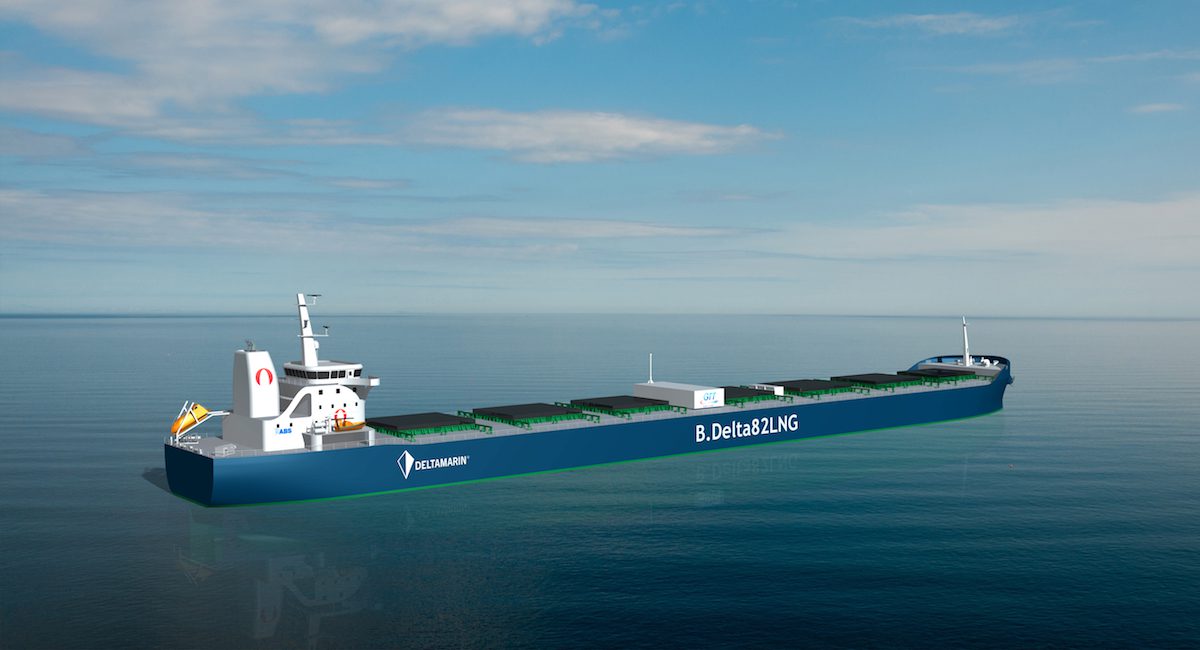Credit: Project Forward
A handful of shipping industry leaders have teamed up in a joint project to develop a dry bulk carrier concept that uses LNG as a fuel.
The project, dubbed Project Forward, involves international classification society ABS, with Arista Shipping, Deltamarin, GTT and Wärtsilä. Plans for the first concept design were revealed this week at Posidonia, the international shipping conference held in Athens, Greece.
The goal of the project is to develop a Kamsarmax bulk carrier design to be the first of this type suitable for worldwide services powered by LNG in compliance with the International Maritime Organization’s Energy Efficiency Design Index 2025 standards, NOx Tier III and Marpol Annex VI SOx emission levels. The design will be the first LNG-fueled dry bulk ship capable of full-range operations.
“The long-term potential for LNG as a marine fuel is tremendous,” says ABS Vice President of Global Gas Solutions Patrick Janssens. “We see the near-term opportunities for larger vessels on fixed and known trade routes, but more opportunities will emerge as concepts mature and bunkering infrastructure expands. Environmental stewardship will continue to be a concern, and owners will be evaluating alternative fuel choices.”
“Project Forward represents a milestone for the shipping industry in bringing to the market a practical, achievable design for what are the workhorses of the shipping fleet,” says Arista Shipping Principal Alexander P. Panagopulos. “Our mission is to develop the next generation of energy efficient and environmental friendly dry bulk cargo ships to be sustainable worldwide beyond 2030. It marks a number of ‘firsts’ and draws together the experience of a team of leaders in their field to make LNG powered shipping a reality on the high seas.”
Technical requirements for the design involve the need to carry a large volume of LNG (2,500 cu. m.), corresponding to full-range operation and 40 days at sea, in a type of ship where available space is limited and cargo space tends to be extremely limited.
For their roles, ABS is to provide Approval in Principle for the concept, which is based on the highly optimized Deltamarin B.Delta 82 design, utilizing a GTT membrane LNG fuel tank. This design also could be applied to other bulk carrier sizes and serve as the basis for an LNG-fueled tanker. The concept features a Wärtsilä four-stroke, medium-speed engine without auxiliary generators, the first time this configuration has been applied to a vessel of this type, significantly simplifying the vessel’s engine room arrangement and contributing to lower capital expenditure.
While Project Forward is seeking to claim the first LNG-fueled dry bulk ship capable of full-range operations, it’s actually not the first dry cargo ship to run on LNG. That title belongs to the MV Greenland, a LNG-fueled dedicated cement carrier built by Ferus Smit and delivered to the joint venture JT cement towards the end of 2015.

 Join The Club
Join The Club











